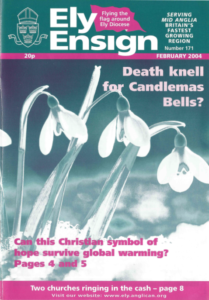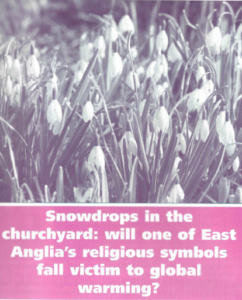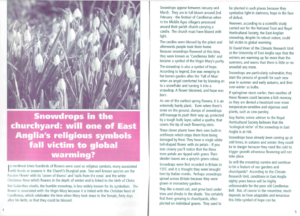Snowdrops in the churchyard
Ely Ensign, February 2004Snowdrops full article
Will one of East Anglia’ religious symbols fall victim to global warming?
This article appeared in the Ely Ensign in February 2004, on page 4.

In medieval times hundreds of flowers were used as religious symbols, many associated with feast or seasons in the Church’s liturgical year. Two well-known species are the Passion Flower with its ‘crown of thorns’ and ‘nails from the cross’ and the white Christmas Rose which flower in the depth of winter and is lined to the birth of Christ.
But Galanthus nivalis, the humble snowdrop, is less widely know for its symbolism. The flower is associated with the Virgin Mary because it is linked with the Christen feast of Candlemas, which celebrates the time when Mary took Jesus to the Temple, forty days after his birth, so that they could be blessed.
Snowdrops appear between January and March. They are in full bloom around 2nd February – the festival of Candlemas when in the Middle Ages villagers processed around their parish church carrying a candle. The church must have blazed with light.
The candles were blessed by the priest and afterwards people took them home. Because snowdrops flowered at this time, they were known as ‘Candlemas Bells’ and became a symbol of the Virgin Mary’s purity.
The snowdrop is also a symbol of hope. According to legend, Eve was weeping in her barren garden after the ‘Fall of Man’ when an angel comforted her by blowing on to a snowflake and turning it into a snowdrop. A flower bloomed, and hope was born.

As one of the earliest spring flowers, it is an extremely hardy plant. Even when there’s snow on the ground, clumps of snowdrops still manage to push their way up, protected by a tough leafy layer, called a spathe, that covers the tip of each flowering stem.
These clever plants have their own built-in antifreeze which stops them from being damaged by frost. They have a single white bell-shaped flower with six petals – if you look closely you’ll notice that the tree inner petals are tipped with green. Their slender leaves are a greyish green colour.
Snowdrops were first recorded in Britain in 1597, and it is thought they were brought here by Italian monks. Perhaps snowdrops spread across Britain because they were grown in monastery gardens.
They like a moist soil, and grow best under trees and shrubs in the shade. You certainly find them growing in churchyards, often planted on individual graves. They used to be planted in such places because they symbolise light in darkness, hoe in the face of defeat.
However, according to a scientific study carried out for the National Trust and Royal Horticultural Society, the East Anglian snowdrop, despite its robust nature, could fall victim to global warming.
Dr David Viner of the Climatic Research Unit at the University of East Anglia says that the winters are warming up far more than the summers, and warns that there is little or no snowfall anymore.
Snowdrops are particularly vulnerable; they start the process of growth for each new year in summer and early autumn, and then over-winter as bulbs.
If springtime starts earlier, then swathes of these flowers could become a folk memory as they are denied a head start over more temperature-sensitive and vigorous seed plants, such as cow parsley.
Guy Barter, senior adviser to the Royal Horticultural Society, believes that the ‘ecological niche’ of the snow drop in East Anglia is at risk.
Snowdrops have already been coming up at odd times, in autumn and winter; they could be in danger because they need the cold to trigger growth otherwise flowering will not take place.
So, will the snowdrop survive and continue to be a feature of our garden and churchyards? According to the Climate Research Unit, conditions in East Anglia eighty years hence will be highly unfavourable for the poor old Candlemas Bell. But, of course in the meantime, much depends on how adaptable and tenacious this little symbol of hope can be.

